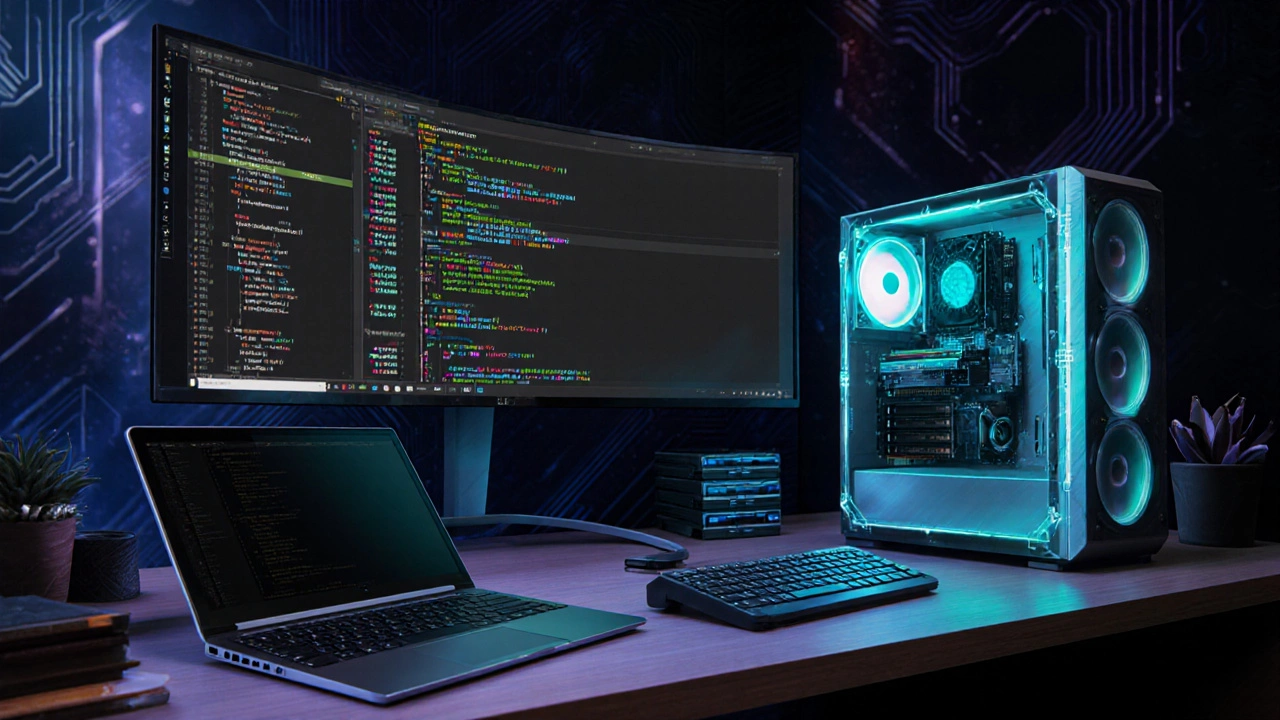
Coding Computer Calculator
Choose Your Coding Needs
Select the options that best describe your development work
Recommended Configuration
Laptop Recommendation
Desktop Recommendation
Why these specs? Based on your needs, this configuration balances performance with your budget and portability preferences.
When picking a computer for coding, you need to balance raw speed, comfort, and what you actually build. A gamer’s rig might feel overkill for JavaScript, while a cheap netbook will choke on data‑science libraries. This guide walks you through the exact specs to look for, shows how different budgets stack up, and helps you decide whether a laptop or a desktop suits your workflow.
Figure out what you’ll be building
The hardware you need starts with the kind of code you write. If you spend most of your time in lightweight text editors, a modest CPU and 8 GB of RAM may suffice. Web front‑end work, mobile app development, and scripting usually stay under 50 GB of RAM and run fine on a mid‑range processor. On the other hand, compiling large C++ projects, training machine‑learning models, or running multiple Docker containers can quickly eat up CPU cycles, memory, and storage I/O.
Ask yourself three quick questions:
- Which programming languages dominate my day‑to‑day work?
- Do I need to run virtual machines, containers, or heavy IDEs like Visual Studio or Android Studio?
- Is portability a must, or can I work from a fixed desk?
Your answers will drive every hardware decision that follows.
Core hardware components you can’t ignore
CPU (central processing unit) is the brain of your machine. Modern coding workloads benefit from higher core counts and strong single‑thread performance. For most languages, a quad‑core 3.5 GHz Intel Core i5‑13th‑gen or AMD Ryzen 5 7600X hits a sweet spot. If you compile large C++ bases or train models locally, step up to an 8‑core Ryzen 7 7700X or Intel i7‑13700K.
RAM determines how many files, libraries, and background services you can keep open. 8 GB is the absolute minimum; 16 GB covers most IDEs, browsers, and lightweight containers. For data‑science, virtual machines, or multitasking power users, 32 GB is a safe ceiling.
SSD storage beats spinning disks by orders of magnitude in read/write speed. An NVMe drive of at least 512 GB speeds up project checkouts, Docker builds, and compiler caches. If you need massive datasets, pair a 1 TB NVMe for the OS and tools with an external HDD for archives.
Most coding tasks don’t need a high‑end GPU. Integrated graphics on modern CPUs handle UI rendering and light UI frameworks. However, if you work with game development, 3D modelling, or GPU‑accelerated ML, a dedicated RTX 3060 or Radeon 6700 XT adds noticeable speed.
Portability vs power: Laptop or Desktop?
Laptop offers the freedom to code from cafés, libraries, or while traveling. Look for a device with a 15‑inch display, a full‑size keyboard, and a Thunderbolt 4 port for fast external storage. A 13‑inch ultrabook like the Dell XPS 13 can be a daily driver if you stick to web development or scripting, but a 16‑inch workstation‑class laptop (e.g., Lenovo ThinkPad P16) gives you desktop‑grade CPUs and dedicated GPUs in a portable chassis.
Desktop shines when raw performance and upgradeability matter. You can fit a larger cooler, more RAM, and multiple drives without worrying about thermal constraints. A mid‑tower with a decent power supply lets you swap graphics cards or add extra storage for years. The trade‑off is you’re tied to a desk.
Decision matrix:
- If you value flexibility and your budget is under $1,200, pick a laptop with an i5‑13th‑gen CPU, 16 GB RAM, and a 512 GB NVMe.
- If you need maximum compile speed, dual‑monitor real estate, or plan to upgrade components, a desktop starting at $1,000 will give you better bang for the buck.
Display, keyboard, and other peripherals
A crisp, color‑accurate monitor reduces eye strain and lets you view more code lines side‑by‑side. Aim for at least a 1080p panel; 1440p or 4K monitors are worth it if you design UI/UX or need extra vertical space. Dual monitors are common among developers - one for code, one for documentation or terminal windows.
Typing comfort is underrated. Mechanical keyboards with tactile switches (e.g., Cherry MX Brown) boost typing speed and reduce fatigue. If you’re on a laptop, consider a USB‑C dock that adds a full‑size keyboard and mouse.
Finally, a reliable IDE like VS Code, IntelliJ, or PyCharm can make the hardware feel faster. Pair a solid monitor and keyboard with the right IDE, and you’ll notice a productivity jump.

Budget tiers and recommended specs
| Budget | CPU | RAM | Storage | GPU | Form Factor |
|---|---|---|---|---|---|
| Entry ($600‑$800) | Intel i5‑13th‑gen or Ryzen 5 5600G | 8 GB (upgrade to 16 GB later) | 512 GB NVMe SSD | Integrated graphics | 13‑15" laptop |
| Mid‑range ($1,000‑$1,400) | Ryzen 7 7700X or Intel i7‑13700 | 16 GB DDR5 | 1 TB NVMe SSD | RTX 3060 (laptop) or GTX 1660 Super (desktop) | 16" laptop or mid‑tower desktop |
| High‑end ($2,000+) | Intel i9‑13900K or Ryzen 9 7950X | 32 GB DDR5 (expandable to 64 GB) | 2 TB NVMe + 2 TB HDD | RTX 4090 or Radeon 7900 XT | 27" 4K monitor + desktop tower |
These tiers give you a concrete starting point. Feel free to swap components - the biggest performance wins usually come from a faster CPU and more RAM for compile‑heavy workloads.
Future‑proofing and maintenance tips
Even the best machine ages. Keep your OS and drivers up to date; it helps with security and can unlock performance patches for newer compilers. Use a tool like CCleaner (or built‑in Windows Disk Cleanup) to clear junk files and keep the SSD healthy.
Plan for expansion. Choose a laptop with at least one M.2 slot and a spare RAM slot. For desktops, buy a PSU with extra wattage headroom - 650 W is a safe baseline for most builds.
Regularly back up your code. A cloud service (GitHub, GitLab) combined with a local external drive safeguards against hardware failure.

Quick takeaways
- Identify the heaviest part of your workflow - compile speed, GPU tasks, or multitasking - and prioritize CPU, GPU, or RAM accordingly.
- For most students and web developers, a 13‑15" laptop with an i5‑13th‑gen CPU, 16 GB RAM, and 512 GB NVMe is sufficient.
- If you need raw power or plan to upgrade, a desktop with a Ryzen 7 7700X, 32 GB RAM, and a dedicated RTX 3060 offers the best price‑to‑performance.
- Invest in a good monitor and mechanical keyboard; they boost comfort more than a marginal CPU bump.
- Leave room for future upgrades - extra RAM slots, M.2 slots, and a decent power supply extend your machine’s life.
Frequently Asked Questions
Do I need a dedicated GPU for programming?
Most coding tasks run fine on integrated graphics. Only game development, 3D rendering, and machine‑learning training benefit from a separate GPU.
Is Windows or macOS better for coding?
Both OSes support major languages, but macOS offers a Unix‑like environment out of the box, which many developers prefer. Windows Subsystem for Linux (WSL) narrows the gap.
How much RAM do I really need?
8 GB is the floor; 16 GB covers most IDEs and browsers comfortably. Go to 32 GB if you run containers, virtual machines, or large datasets.
Can I start with an older laptop and upgrade later?
Upgrading laptops is limited. Look for models with a free M.2 slot and replaceable RAM; otherwise, plan a desktop upgrade path.
What storage type gives the best coding experience?
NVMe SSDs deliver the fastest read/write times, reducing project load and build times dramatically compared to SATA SSDs or HDDs.




